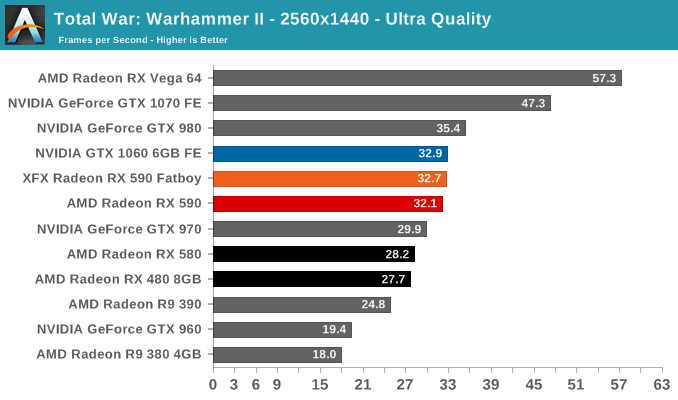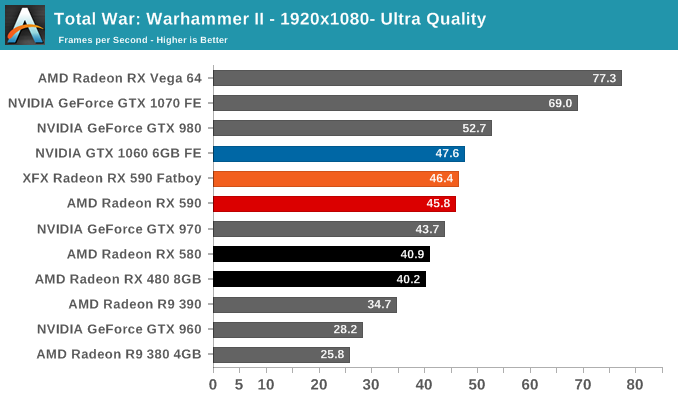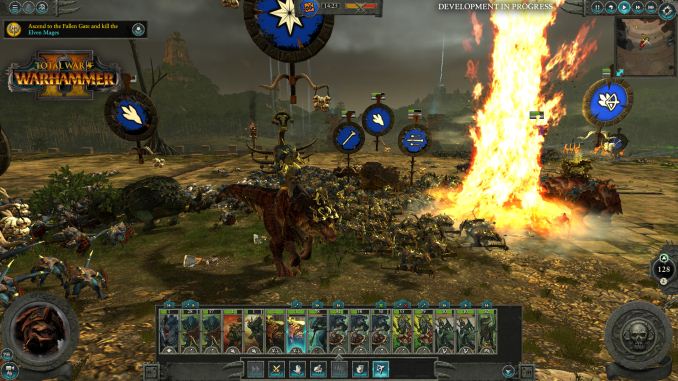The AMD Radeon RX 590 Review, feat. XFX & PowerColor: Polaris Returns (Again)
by Nate Oh on November 15, 2018 9:00 AM ESTTotal War: Warhammer II (DX11)
Last in our 2018 game suite is Total War: Warhammer II, built on the same engine of Total War: Warhammer. While there is a more recent Total War title, Total War Saga: Thrones of Britannia, that game was built on the 32-bit version of the engine. The first TW: Warhammer was a DX11 game was to some extent developed with DX12 in mind, with preview builds showcasing DX12 performance. In Warhammer II, the matter, however, appears to have been dropped, with DX12 mode still marked as beta, but also featuring performance regression for both vendors.
It's unfortunate because Creative Assembly themselves have acknowledged the CPU-bound nature of their games, and with re-use of game engines as spin-offs, DX12 optimization would have continued to provide benefits, especially if the future of graphics in RTS-type games will lean towards low-level APIs.
There are now three benchmarks with varying graphics and processor loads; we've opted for the Battle benchmark, which appears to be the most graphics-bound.


Along with GTA V, Total War: Warhammer II is the other game in our suite where the GTX 1060 6GB FE remains in the lead even against factory-overclocked RX 590s. NVIDIA hardware all fare well here, and for the RX 590 it has at least made up enough ground to nip at the GTX 1060 6GB FE's heels. And while the RX 590 represents a decent jump from R9 390 levels, it is still priced higher and draws more power than the GTX 1060 6GB.











136 Comments
View All Comments
deksman2 - Friday, November 16, 2018 - link
It would be an unfair comparison because AMD is using GLOFO 12nm LP node designed for low clocks and mobile parts, whereas NV is using TSMC 16nm high performance process designed for high clocks and efficiency.You can't compare the two back to back and NV would still win in such a situation.
But, for the sake of argument, a Polish website (at least I think it was Polish) apparently managed to undervolt RX 590 just recently and total power consumption dropped by 34W.
Here's the website:
https://pclab.pl/art79190-20.html
Polaris power consumption problems stem from a combination of problems:
1. (and this would be the biggest) GLOFO 14nm/12nm process nodes designed for low clocks and mobile parts (not worth it even raising frequencies on 12nm because as we saw, both Ryzen+ and Polaris were already boosting WAY past the GLOFO node 'comfort zone' to the point efficiency was thrown out the window.
2. lower yields on GLOFO nodes contributed towards lack of voltage optimisation resulting in higher maximum voltages on GPU's shipping from factory.
3. Excessive amount of compute hardware. Polaris has powerful compute which is not really used in games, and this hardware does suck up a lot of power, and Polaris in general has about 40% more stream processors than Pascal has CUDA cores.
Kurosaki - Friday, November 16, 2018 - link
I still don't see any incitement to upgrade from my 290X, sad in a way.. : /eva02langley - Friday, November 16, 2018 - link
Vega 56 if they are on sale for the right price...However yeah, no reason to change.
The_Assimilator - Friday, November 16, 2018 - link
*sound of dead horse being beaten*Santoval - Friday, November 16, 2018 - link
How long will AMD keep squeezing the blood out of Polaris? They have practically abandoned their GPU division, their mainstream one anyway. A single refresh could be occasionally justified, but a refresh-squared of the same GPU (or GPU series) equates with rebranding.I realize that they overwhelmingly focused on their CPU and APU division in order to compete with Intel, and that drew resources and engineers from the GPU division. But competition is required in the GPU market as well, or else Nvidia will keep charging an arm and a leg for their graphics cards.
samal90 - Friday, November 16, 2018 - link
you didn't mention in the Wolfenstein 2 page, that the RX590 performs like a GTX 1070. It's an interesting observation that should be investigated.deksman2 - Friday, November 16, 2018 - link
Probably because the game is well optimised for AMD hardware (a situation which is all too uncommon).But AMD's main problems stem from using an inefficient GLOFO nodes.
14nm and 12nm were both designed for low clocks and mobile parts... this is why we see massive increase in power consumption for Polaris at high frequencies... because the GPU is clocked WAY past the voltage comfort zone where it would be efficient.
TSMC nodes are designed for high clocks and efficiency... and as such, they WILL have an advantage in clocks and power consumption.
DominionSeraph - Friday, November 16, 2018 - link
Does this win the award for most pointless launch of all time? Anyone who was in the market for a GTX 970/1060 class GPU in the GTX 970/1060 price range probably bought a GTX 970 or GTX 1060 already. Releasing a more power hungry card over 4 years late doesn't really seem like it's going to move the market.When Nvidia was 6 months late with the housefire GTX 480 they at least had the performance crown compared to the 5870. This is 4 years late and has nothing.
spdfreak - Saturday, November 17, 2018 - link
Seems like a used RX 480 8GB is probably the best value out there for 1080 gaming. Plenty of them for about 100.00 on ebay. I keep looking for the price of 1060 6GB cards to come down now that there is a glut of them, but they stay stubbornly high.neblogai - Sunday, November 18, 2018 - link
RX570s are about as fast as RX480, but start at ~$150. They are new, come with warranty, and with 2 AAA games which can be considered to be worth ~$120 if you want them, or ~$60 for reselling. RX570 is a better deal.